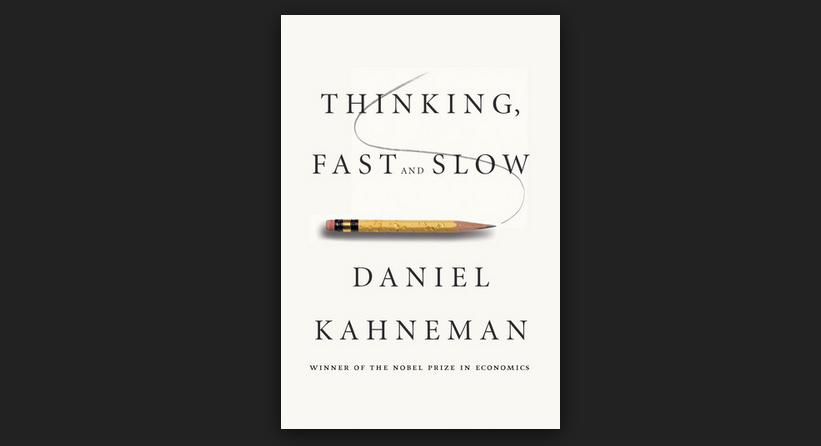Thinking, Fast and Slow: Book Review & Lessons Learned
Photo: Wikipedia
We wanted to share some takeaways from one of our favorite books – Thinking Fast and Slow. This book is a masterpiece and will make you think about how you and others come to conclusions about what is true in the world. Simply put, it provides a framework for understanding the circumstances in which people repeatedly make irrational decisions. You will be surprised at how the author – Nobel Laureate Daniel Kahneman – makes this topic easy and fun to explore.
As we know you are busy and may not have time to digest this book in its entirety, please consider finding time to read the introduction and then review a few of our favorite sections, which we have highlighted below.
--
1) System 1 and System 2 (pages 19 - 27)
We think of ourselves as in control of our minds. Kahneman describes two systems that govern how the mind works, one we control and one we do not. System 2 represents the conscious self that makes choices and decides what to do. System 1 represents the instinctual mental events that allow us to make quick decisions with little mental energy. We could not survive without System 1 and yet it often causes us to make systematic errors in specific situations. The following exercise from the book is an example of this conflict between System 1 and System 2.
source: Google Books Preview, Thinking, Fast and Slow {page 25}
"..learn to recognize situations in which mistakes are likely and try harder to avoid significant mistakes when the stakes are high. The premise of this book is that it is easier to recognize other people's mistakes than our own." {page 28}
--
2) Resemblance & Base Rates (pages 6 & 146)
You will find the discussions of Steve and Tom to be thought provoking. They show how humans are wired to ignore statistical evidence when presented in context of qualitative information. Please review the questions on these pages as you may find (as we did) that you are wired to sometimes make quick and flawed judgments.
--
3) Answering Easier Questions (pages 97 - 99)
The studies discussed here show how, in complex situations, decisions are often made by feelings of like and dislike, with little deliberation or reasoning. From an investment perspective this is how difficult questions like “Do I believe that ACME Corporation is attractively priced?” are frequently and unknowingly substituted with questions that are easier to answer, such as, “Do I like ACME Corporation, its CEO and its products?” or “How excited or fearful am I about the world right now?” These easier-to-answer questions are susceptible to having highly volatile answers that are not rooted to a company’s underlying financial results. This sometimes causes good companies to be offered at very low prices and is therefore a key creator of the investment opportunities Euclidean seeks.
"..a lazy System 2 often follows the path of least effort and endorses a heuristic answer without much scrutiny of whether it is truly appropriate. You will not be stumped, you will not have to work very hard, and you may not even notice that you did not answer the question you were asked.” {page 99}
--
4) Anchoring (Chapter 11, page 119)
This is an important chapter to have in mind when navigating a negotiation or considering a price. As an illustrative example, you might find it interesting that most people when asked whether Gandhi was more than 114 years old when he died, will provide a much larger estimate of his age at death than they would if the anchoring question referred to death at 35 years old. The funny and powerful examples shared here show that our behavior is influenced, much more than we know or want, by the environment of the moment.
Consider how this effect contributes to a stock hitting irrational highs or pessimistic lows that deviate from the stock’s true value.
"The psychological mechanisms that produce anchoring make us far more suggestible than most of us would want to be. And of course there are quite a few people who are willing and able to exploit our gullibility." {page 126}
--
5) Overconfidence & The Illusion Of Skill (pages 209 - 220)
People tend to jump to conclusions based on little evidence and are demonstrably bad at predicting the future. Strikingly, even the knowledge that people tend to be bad at predicting the future tends to have little effect on individuals’ confidence in their own predictions and their thirst for ‘expert’ prognostications.
".. declarations of high confidence mainly tell you that the individual has constructed a coherent story in his mind, not necessarily that the story is true." {page 212}
--
6) Intuitions vs. Formulas (pages 221 – 233)
This section is near and dear to Euclidean’s reason for being. It discusses how, in environments with high degrees of uncertainty, simple statistical formulas tend to outperform collections of experts. Check out these pages for how this has been found to be true in predicting the future value of Bordeaux wines, the likelihood that a convict will violate parole, and success in pilot training.
"Several studies have shown that human decision makers are inferior to a prediction formula, even when they are given the score suggested by the formula! They feel that they can overrule the formula because they have additional information about the case, but they are wrong more often than not." {page 224}
Additional resources on Thinking, Fast and Slow
New York Times Book Review - Two Brains Running
WSJ Book Review - Why the Grass Seems Greener
The Economist - The father of behavioral economics considers the feeble human brain


